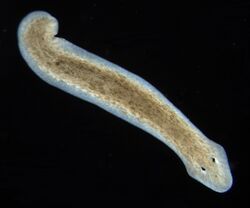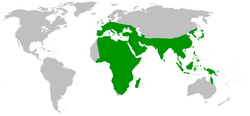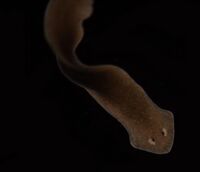Biology:Dugesia
| Dugesia | |
|---|---|

| |
| Dugesia subtentaculata | |
| Scientific classification | |
| Domain: | Eukaryota |
| Kingdom: | Animalia |
| Phylum: | Platyhelminthes |
| Order: | Tricladida |
| Family: | Dugesiidae |
| Genus: | Dugesia Girard, 1850[1] |
| Species | |
|
See text | |

| |
| Distribution of genus Dugesia after Sluys et al. 1998.[2] | |
| Synonyms | |
| |
Dugesia (/duˈd͡ʒiʒ(i)ə/ ) is a genus of dugesiid triclads that contains some common representatives of the class Turbellaria. These common flatworms are found in freshwater habitats of Africa, Eurasia, and Australia. Dugesia is best known to non-specialists because of its regeneration capacities.[2]
Dugesia is the type genus of the family Dugesiidae.
Description
Dugesia species have an elongated body with a slightly triangle-shaped head. Usually they have grey, brown or black colors on the dorsal body surface, the ventral surface uses to be paler. These animals have a couple of eyes constituted by a multicellular pigmented cup with many retinal cells to detect the amount of light in the nearby environment. Sometimes they present supernumerary eyes. At the anterior part of the body, behind the eyes level, they have two of structures called auricles that give the triangle look to the 'head' and that allow them to detect the intensity of water current. These auricles are free of pigment and rhabdites. Each side of the anterior margin of the head have between 5 and 10 shallow sensory fossae, their number depends on the species or the individual. The sensory fossae and the auricle grooves are supplied with many nerve endings.[3]
Dugesia digestion tract consists of a central non-pigmented tubular pharynx. Like the other triclads, Dugesia's gut consists in three ramified branches. Each branch consists of ceca, which delivers the nutrients to the body. This worm has a sac digestive plan, that is, it does not have a separate opening for waste excretion.[4]
Subepidermal musculature is divided in four layers.[3]
In Dugesia the ovaries are ventrally situated, they start just behind the brain, usually at the level of the fourth intestinal branch. The bursal canal runs on the right side of the copulatory apparatus and above the atrium.[3] Like some Neppia species, Dugesia have a third layer of longitudinal musculature over the vaginal area of the bursal canal. This feature is not present in other triclads. Another feature shared with Neppia is the presence of a glandular area at the transicional area between the seminal vesicle and the ejaculatory duct, although in Dugesia these glands are concentrated at the diaphragm, a structure not present in any other genera.[5] Ball proposed that the presence of this glands was a synapomorphy of Dugesia and Neppia. The absence of these glands in some Neppia species (N. jeanneli, N. montana and N. schubarti) is thought to be a secondary loss.[6]
Reproduction
They are hermaphrodites. Many species can reproduce both sexually and asexually (by parthenogenesis or by fission).[7]
Phylogeny and taxonomy
Dugesia species have not enough morphological characters to find out which are the relationships between them. Furthermore, those available use to contradict each other. Dugesia species are identified by the combination of diagnostic characters instead of different apomorphies. Over 70 species within the genus Dugesia have been described.[2]
Phylogeny
Phylogenetic tree including five dugesiid genera after Álvarez-Presas et al., 2008:[8]
| Dugesiidae |
| ||||||||||||||||||||||||
Molecular phylogeny of 13 Dugesia species after Lázaro et al., 2009:[9]
| Dugesia |
| ||||||||||||||||||||||||||||||||||||||||||||||||||||||||||||||||||||||||
Molecular phylogeny of Dugesia species after Solà et al., 2013:[10]
| Dugesia |
| ||||||||||||||||||||||||||||||||||||||||||||||||||||||||||||||||||||||||||||||||||||||||||||||||||||||
Species
The following species are currently recognised in the genus Dugesia:[11]
- Dugesia absoloni (Komarek, 1919)
- Dugesia adunca Chen & Sluys, 2022[12]
- Dugesia aenigma De Vries, 1984
- Dugesia aethiopica Stocchino, Corso, Manconi & Pala, 2002
- Dugesia afromontana Stocchino & Sluys, 2012
- Dugesia andamanensis (Kaburaki, 1925)
- Dugesia annandalei (Kaburaki, 1918)
- Dugesia arabica Harrath & Sluys, 2013
- Dugesia arcadia De Vries, 1988
- Dugesia ariadnae De Vries, 1984
- Dugesia artesiana Sluys & Grant, 2007
- Dugesia astrocheta Marcus, 1953
- Dugesia aurea Leria, 2020
- Dugesia austroasiatica Kawakatsu, 1985
- Dugesia bactriana de Beauchamp, 1959
- Dugesia bakurianica Porfirieva, 1958
- Dugesia batuensis Ball, 1970
- Dugesia benazzii Lepori, 1951
- Dugesia bengalensis Kawakatsu, 1983
- Dugesia biblica Benazzi & Banchetti, 1973
- Dugesia bifida Stocchino & Sluys, 2014
- Dugesia bijuga Harrath & Sluys, 2019
- Dugesia borneana Kawakatsu, 1972
- Dugesia brachycephala (Bohmig, 1897)
- Dugesia brigantii De Vries & Benazzi, 1983
- Dugesia burmaensis (Kaburaki, 1918)
- Dugesia capensis Sluys, 2007
- Dugesia chichkovi (Hranova, 1929)
- Dugesia circumcisa Chen & Dong, 2021[13]
- Dugesia constrictiva Chen & Dong, 2022[14]
- Dugesia corbata Leria, 2020
- Dugesia cretica (Meixner, 1928)
- Dugesia damoae De Vries, 1984
- Dugesia debeauchampi De Vries, 1988
- Dugesia deharvengi Kawakatsu & Mitchell, 1989
- Dugesia didiaphragma De Vries, 1988
- Dugesia dubia (Borelli, 1895)
- Dugesia ectophysa Marcus, 1953
- Dugesia elegans De Vries, 1984
- Dugesia etrusca Benazzi, 1944
- Dugesia fissipara (Kennel, 1888)
- Dugesia foeni Ball, 1977
- Dugesia fontinalis (Nurse, 1950)
- Dugesia gemmulata Sun & Wang, 2022[15]
- Dugesia golanica Bromley & Benazzi, 1991
- Dugesia gonocephala (Duges, 1830)
- Dugesia gonocephaloides Girard, 1850
- Dugesia hepta Pala, Casu & Vacca, 1981
- Dugesia hoernesi (Weiss, 1909)
- Dugesia hymanae (Sivickis, 1928)
- Dugesia iheringii (Bohmig, 1887)
- Dugesia ilvana Lepori, 1948
- Dugesia indica Kawakatsu, 1969
- Dugesia indonesiana Kawakatsu, 1973
- Dugesia iranica Livanov, 1951
- Dugesia izuensis Kato, 1943
- Dugesia japonica Ichikawa & Kawakatsu, 1964
- Dugesia krishnaswamyi Kawakatsu, 1975
- Dugesia lamottei de Beauchamp, 1952
- Dugesia lanzai Banchetti & del Papa, 1972
- Dugesia lata (Sivickis, 1923)
- Dugesia laurentiana (Borelli, 1897)
- Dugesia leclerci Kawakatsu & Mitchel, 1995
- Dugesia leporii Pala, Stocchino, Corso & Casu, 2000
- Dugesia libanica Bromley & Benazzi, 1991
- Dugesia liguriensis De Vries, 1988
- Dugesia lindbergi de Beauchamp, 1959
- Dugesia machadoi de Beauchamp, 1952
- Dugesia maculata (Leidy, 1847)
- Dugesia maghrebiana Stocchino, Manconi, Corso, Sluys, Casu & Pala, 2009
- Dugesia majuscula Chen & Dong, 2021
- Dugesia malickyi De Vries, 1984
- Dugesia mertoni (Steinmann, 1914)
- Dugesia michaelsoni (Bohmig, 1902)
- Dugesia microbursalis (Hyman, 1931)
- Dugesia milloti Beauchamp, 1952
- Dugesia minotauros De Vries, 1984
- Dugesia mirabilis De Vries, 1988
- Dugesia modesta Girard, 1893
- Dugesia monomyoda Marcus, 1953
- Dugesia montana Nurse, 1950
- Dugesia myopa De Vries, 1988
- Dugesia nannophallus Ball, 1970
- Dugesia nansheae De Vries, 1988
- Dugesia neumanni (Neppi, 1904)
- Dugesia nonatoi Marcus, 1946
- Dugesia notogaea Sluys & Kawakatsu, 1998
- Dugesia novaguineana Kawakatsu, 1976
- Dugesia polyorchis (Fuhrmann, 1912)
- Dugesia precaucasica Porfirieva, 1958
- Dugesia pustulata Harrath & Sluys, 2019
- Dugesia rincona Marcus, 1954
- Dugesia ryukyuensis Kawakatsu, 1976
- Dugesia sagitta (Schmidt, 1861)
- Dugesia schauinslandi (Neppi, 1904)
- Dugesia seclusa (de Beauchamp, 1940)
- Dugesia semiglobosa Chen & Dong, 2021
- Dugesia siamana Kawakatsu, 1980
- Dugesia sicula Lepori, 1948
- Dugesia similis (Bohmig, 1902)
- Dugesia sinensis Chen & Wang, 2015
- Dugesia subtentaculata (Draparnaud, 1801)
- Dugesia superioris Stocchino & Sluys, 2013
- Dugesia tamilensis Kawakatsu, 1980
- Dugesia tanganyikae (Laidlaw, 1906)
- Dugesia taurocaucasica (Livanov, 1951)
- Dugesia transcaucasica (Livanov, 1951)
- Dugesia tubqalis Harrath & Sluys, 2012
- Dugesia tumida Chen & Sluys, 2022[12]
- Dugesia uenorum Kawakatsu & Mitchel, 1995
- Dugesia umbonata Song & Wang, 2020
- Dugesia venusta (Bohmig, 1897)
- Dugesia verrucula Chen & Dong, 2021)[13]
- Dugesia vestibularis De Vries, 1988
- Dugesia wytegrensis (Sabussow, 1907),
References
- ↑ Girard (1851). Essay on the classification of Nemertes and Planariae, preceded by some general considerations on the primary divisions of the animal kingdom. Proceedings of the American Association for the Advancement of Science. 4th Mtg, New Haven, Conn., Aug 1850, pages 258-273. Washington 1851.
- ↑ 2.0 2.1 2.2 Sluys, Ronald; Kawakatsu, Masaharu; Winsor, Leigh (October 1998). "The genus Dugesia in Australia, with its phylogenetic analysis and historical biogeography (Platyhelminthes, Tricladida, Dugesiidae)". Zoologica Scripta 27 (4): 273–290. doi:10.1111/j.1463-6409.1998.tb00461.x.
- ↑ 3.0 3.1 3.2 Vries, Elizabeth J. (April 1988). "A synopsis of the nominal species of the subgenus Dugesia (Platyhelminthes: Tricladida: Paludicola) from Africa and Madagascar". Zoological Journal of the Linnean Society 92 (4): 345–382. doi:10.1111/j.1096-3642.1988.tb01729.x.
- ↑ Gilbertson L. (1999). Zoology Lab Manual. McGraw Hill Companies, New York; ISBN:0-07-237716-X (fourth edition, 1999).
- ↑ Ball. I. R. (1974). A contribution to the phylogeny and biogeography of the freshwater triclads (Platyhelminthes: Turbellaria). In Biology of the Turbellaria: 339-401. Riser, N. W. & Morse, M. P. (Eds). New York:McGraw-Hill.
- ↑ Vries, Elizabeth J.; Sluys, Ronald (January 1991). "Phylogenetic relationships of the genus Dugesia (Platyhelminthes, Tricladida, Paludicola)". Journal of Zoology 223 (1): 103–116. doi:10.1111/j.1469-7998.1991.tb04752.x.
- ↑ Lentati, G. Benazzi (1966). "Amphimixis and pseudogamy in fresh-water triclads: Experimental reconstitution of polyploid pseudogamic biotypes". Chromosoma 20 (1): 1–14. doi:10.1007/BF00331894.
- ↑ Álvarez-Presas, Marta; Baguñà, Jaume; Riutort, Marta (May 2008). "Molecular phylogeny of land and freshwater planarians (Tricladida, Platyhelminthes): From freshwater to land and back". Molecular Phylogenetics and Evolution 47 (2): 555–568. doi:10.1016/j.ympev.2008.01.032. PMID 18359250.
- ↑ Lázaro, Eva M.; Sluys, Ronald; Pala, Maria; Stocchino, Giacinta Angela; Baguñà, Jaume; Riutort, Marta (September 2009). "Molecular barcoding and phylogeography of sexual and asexual freshwater planarians of the genus Dugesia in the Western Mediterranean (Platyhelminthes, Tricladida, Dugesiidae)". Molecular Phylogenetics and Evolution 52 (3): 835–845. doi:10.1016/j.ympev.2009.04.022. PMID 19435604.
- ↑ Solà, Eduard; Sluys, Ronald; Gritzalis, Konstantinos; Riutort, Marta (March 2013). "Fluvial basin history in the northeastern Mediterranean region underlies dispersal and speciation patterns in the genus Dugesia (Platyhelminthes, Tricladida, Dugesiidae)". Molecular Phylogenetics and Evolution 66 (3): 877–888. doi:10.1016/j.ympev.2012.11.010. PMID 23182762.
- ↑ "WoRMS - World Register of Marine Species - Dugesia Girard, 1850". https://www.marinespecies.org/aphia.php?p=taxdetails&id=181568.
- ↑ 12.0 12.1 Chen, Guang-wen; Wang, Lei; Wu, Fan; Sun, Xiao-juan; Dong, Zi-mei; Sluys, Ronald; Yu, Fei; Yu-wen, Yan-qing et al. (23 May 2022). "Two new species of Dugesia (Platyhelminthes, Tricladida, Dugesiidae) from the subtropical monsoon region in Southern China, with a discussion on reproductive modalities". BMC Zoology 7 (1): 25. doi:10.1186/s40850-022-00127-8. PMID 37170346.
- ↑ 13.0 13.1 Wang, Lei; Chen, Jin-zi; Dong, Zi-mei; Chen, Guang-wen; Sluys, Ronald; Liu, De-zeng (8 September 2021). "Two new species of Dugesia (Platyhelminthes, Tricladida, Dugesiidae) from the tropical monsoon forest in southern China". ZooKeys (1059): 89–116. doi:10.3897/zookeys.1059.65633. ISSN 1313-2989. PMID 34594150.
- ↑ Wang, Lei; Wang, Yixuan; Dong, Zimei; Chen, Guangwen; Sluys, Ronald; Liu, Dezeng (15 December 2021). "Integrative taxonomy unveils a new species of Dugesia (Platyhelminthes, Tricladida, Dugesiidae) from the southern portion of the Taihang Mountains in northern China, with the description of its complete mitogenome and an exploratory analysis of mitochondrial gene order as a taxonomic character". Integrative Zoology 17 (6): 1193–1214. doi:10.1111/1749-4877.12605. ISSN 1749-4877. PMID 34783153.
- ↑ Liu, Yi; Song, Xiao-Yu; Sun, Zhong-Yin; Li, Wei-Xuan; Sluys, Ronald; Li, Shuang-Fei; Wang, An-Tai (29 June 2022). "Addition to the known diversity of Chinese freshwater planarians: integrative description of a new species of Dugesia Girard, 1850 (Platyhelminthes, Tricladida, Dugesiidae)". Zoosystematics and Evolution 98 (2): 233–243. doi:10.3897/zse.98.83184. ISSN 1435-1935.
External links
- "Dugesia". Encyclopedia of Life. http://www.eol.org/pages/51564. Retrieved 2011-04-23.
- Castilla, Juan C (December 2000). "Dos especies nuevas dedicadas al Dr. Patricio Sánchez R" (in es). Revista chilena de historia natural 73 (4). doi:10.4067/S0716-078X2000000400009.
Wikidata ☰ Q310745 entry
 |



